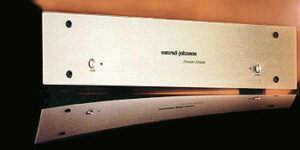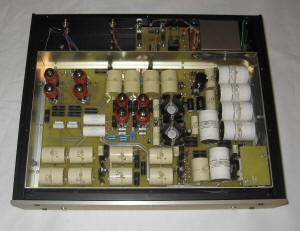Think of the cardboard drink carrier that you get at the counter of a fast food restaurant when you order several drinks. The carrier doesn’t interact with the drinks in any way. The carrier doesn’t make the drinks colder or warmer or sweeter. It is simply a means to conveniently transport the drinks from one location to another.

This is the Conrad Johnson Premier 15 Series 2 phono preamplifier. It does nothing to the music signal except amplify it, simply providing a vehicle for transporting the signal from the input jacks to the output jacks, Super Sized® but otherwise unchanged. It is extremely quiet and exceedingly neutral. It sounds like whatever tubes are installed. In my system, the stock tubes (which were not new when I received the Premier 15) could sound just a bit dry depending on the cartridge or other parts of the system, although they were very quiet. If you want a warmer sound, you might install some NOS Mullard tubes. For a different perspective, Telefunkens may have promise. It is up to you. My practice is to recommend components and parts that you can obtain easily, so my tube experiments will focus on current production 12AX7s. Please note that I am not planning to do an audio survey of all current production 12AX7s. I will add to this review as those experiments warrant. For the time being, the stock tubes sound fine. I’ll report later about some cryo EIs that are on their way from Tube Man.
The Premier 15 would work well in more systems if it had more gain. Even with the medium output cartridges like the Shelter 90x or Clearaudio Insider at 0.6 mv, it will be necessary to run many preamps in their upper range, sometimes getting into their noisy volume settings. Noise was never a problem with the very quiet BAT VK-300xSE integrated amplifier that I used for the majority of this review, but the BAT was happier when the preamp section was not working so hard. There is no problem if your system can accommodate the C-J’s 54 dB of gain. I also wished for more load impedance settings than 200, 500, 1.9k, 9.6k, or 47k ohms, since both Koetsu and Shelter cartridges prefer 100 ohms. An 8 position DIP switch, in place of the current 4 position switch, would provide more settings for only a minor increase in parts cost. However, it was easy enough to replace one pair of resistors (I removed the 9.6k ohms) with 100 ohm Caddocks from Welborne Labs, although the warranty went bye-bye in the process. Of course, in the audiophile quest for great sound, we don’t worry about minor details like warranties, do we?
The removable power cord was helpful, and I used a PS Audio xStream Plus power cord with a small increase in midrange resolution. That switch on the left is a subsonic filter. A mute switch might be more useful for many users, but since this feature is often included with current preamplifiers, there is no need to duplicate it. I have not felt the need to use the subsonic filter even without a vacuum record hold-down on my turntable to flatten warped records. One other observation before we get down to business. The quality and precision of the case is exceptional. It is standard CJ, meaning it is high quality, well made and functional, but not too fancy. Every screw hole lines up exactly with its associated hole in the top and bottom panels. This is especially welcome since the cover is destined to be removed and reinstalled many times as different tubes are tried.
It’s time to lower the cueing lever. It takes about 10 seconds to realize that good things are happening. The Premier 15 Series 2 provides a soundstage that is very naturally deep and wide with pinpoint precision. It is as realistic as I have ever heard from recorded music. There is one very small character to the ’15-2, one that is common with most tube gear: the bass is just very slightly soft. But this is relative to some other units, especially solid-state ones, and not an actual weakness of the Premier 15. Otherwise, this phono preamplifier has less of an effect on the music than any other similar device I have heard, with the result that it is easily the most enchanting and involving phono stage I have heard.

The C-J seems to not hold on to the notes at all as they pass through the internal circuitry, and this results in a presentation that is completely lacking in smear or confusion. Speed, precision, clarity and resolution are terms easily associated with the Premier 15-2. Music just flows unmolested and unchanged. I hear many new details every time I play an album I thought I knew very well. It is important to keep in mind that this sense of clarity and realism is not the result of any frequency imbalance in the midrange, or especially any emphasis in the lower treble. The former can give a false sense of body, and the latter is an effect that is often associated with transparency. The overall balance from the low bass to high treble is completely natural and reflects exactly how the recording was made. The natural balance means that listening for hours is a real pleasure.
The timing is perfect because micro- and macro-dynamics are perfectly in sync with each other. The presentation is always harmonically rich, with a very natural, unforced quality that indicates a superior design using the best possible parts. It is amazing just how much other phono stages affect the signal by imposing their own sonic fingerprint, but the Premier 15 is as responsive and clear to the music as an open doorway. Conrad Johnson suggests that this clarity is the result of the large and expensive film capacitors, specially chosen resistors, and fast recovery power supply diodes. It all works marvelously well to get out the way and let the music sound gloriously free and alive.
Late in the audition I replaced the stock tubes with cryo-treated EI “Silver Bullet” 12AX7s and cryo-treated Mullard 6GK5s. These took about 30 hours to break in. Any reservation I had about a dry, lack of harmonically developed sound that could exacerbate the rough sound of older discs or those that were recorded using less than audiophile equipment have happily departed. This phono stage is wonderful. For the first time, I am feeling guilty about the amount of time – and the almost wicked desire to spend it – listening to the music with the Premier 15 in my system. Very, very good. And then, oh brother. Then… I plugged in an Air Tight ATH-1 MC step-up transformer. The digital volume control on the BAT integrated went from 120 without the Air Tight to 75 with it (the maximum is 140). Take one giant step forward. This is reality. Go to an orchestral concert. Sit about 10-20 rows back. This is how this CJ/Air Tight combination sounds. No emphasis, no glare, no noise – none, entirely and completely transparent. Voices hang in space, and acoustic instruments have 3 dimensions that leave very little to be filled in by the imagination. This combination is quite revelatory. Back to earth, now. (see note 1)
This is the straight wire with gain we all desire, although the wire itself is made of vacuum tubes that have more or less of a sound of their own. So if you don’t like the sound of the Premier 15-2, pick your tubes with care because that is the sound you will hear. The Premier 15 is an excellent platform for tube rollers or for those who don’t want to bother with anything but CJ’s specially selected tubes. Both kinds of buyers will get great sound. At $5000, I suggest that the Premier 15 Series 2 is an “exit level” product, meaning that after you acquire it, you can exit your search for a great phono stage. Through many enjoyable listening sessions, I never really heard this preamplifier. And that is just perfect!
Overall Rating: 10 LPs

Note 1. Take a look at the image above. A pair of Jensen MC step-up transformers will fit nicely right by the input RCAs at the left rear. So, how about a Premier 15 with…
…75 dB of gain…
…AND, easy DIP switch loading adjustment for almost any cartridge? Now that is exciting!
And just like magic, it is done! Jump to the Project write-up by clicking HERE.
